Who is to blame for the slowness of games on PC - processors or video cards? We define the "extreme" on the example of modern games

Hello% username%! It is unlikely that anyone will be surprised by the fact that games are now stamped in a conveyor way, and a gaming PC is simply associated with a pile of expensive iron. There is no desire to litter money in a crisis, but you want to play! Today we will find out for which games a powerful processor is more important, and which ones, on the contrary, rely on the performance of a video card. And at the same time we will determine the portrait of the optimal gaming PC at the turn of 2016-2017.
In an amazing time we live, comrades! On the one hand, computers have not been developing at an explosive pace for a long time - with the evolution of processors in recent years, a disgrace has taken place, and a large part of video cards simply change nameplates from year to year until a new technical process arrives. But it is worth starting to talk about the optimization of software or games and to consider in particular how the public will immediately be indignant and hint, saying "you, old man, stop catching fleas and buy yourself at last a normal iron." And if you do not have money for a normal iron - buy a console, in which there is no need to select components for games.
And after all, they are partly right - in the consoles do not need to puzzle over the bundle. Instead, depending on the chosen system, the set of games - exclusives will differ, as they say now. And what if you come up with the PC configuration from the reverse, and choose the hardware with an eye on the requirements for the processor or graphics of the various games? Will games on the same engine work equally well on a fixed configuration? Today we will try to understand these issues.
')
"Late to drink Borjomi" - which computers are no longer gaming
We will have to hit the “how quickly time flies” syndrome again, but let's observe some conventions. For someone, a PC capable of running games in a flash player is also a kind of gaming, but by gaming computer we mean a machine with:
- Full HD monitor
- Capable of delivering over 30 fps in a single player and over 50 fps in multiplayer
- Suitable for high or maximum detail settings in modern games
And modern games are at least titles of 2013 and later. The fact that in our minds the year 2007-2010 was just recently is our only illusion. Because, as children who were born in 2010, it is frightening to think, they have already grown up and have become a new caste of gamers. This means nostalgia and excuses "anyway, before the games were better," it is better not to use them in discussions about modern igromashina ".
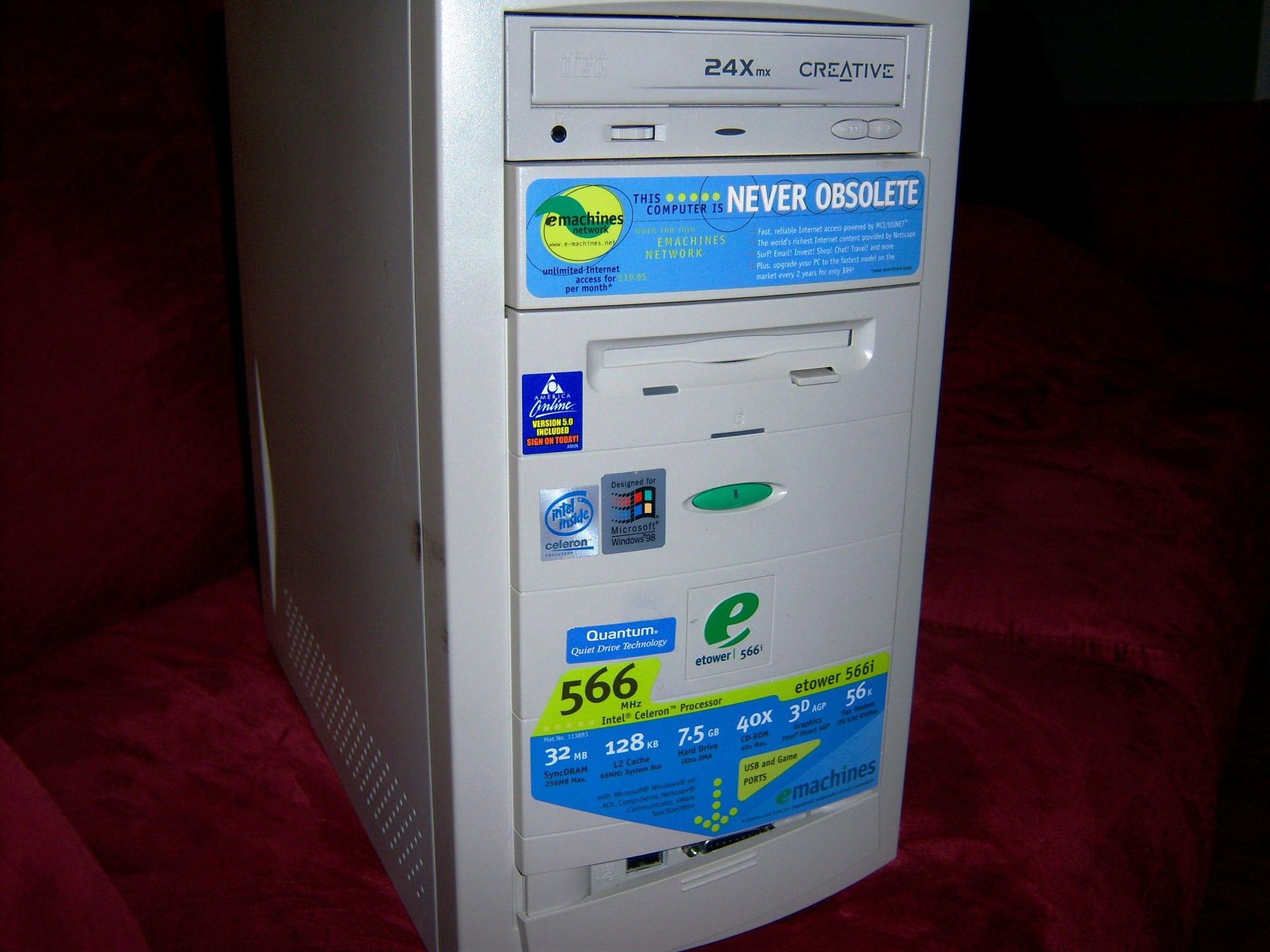
Forever young, oh, ever drunk!
Of these theses, there is a certain threshold for the minimum acceptable iron for games - a dual-core chip with Hyper Threading (maximum 4 years old) or lower quad-core when it comes to processors, as well as three-four-year video cards of a level higher than middle-end. Less productive iron has moved from the game category to “I fit in and so, I play not in graphics, but in gameplay!” Or for free-to-play games in which donation is more important than visual technologies.
Console emulators - need more CPU
For high performance games in PC console emulators, you need a fast CPU, because the simulation of the latest consoles often occurs in a slow interpretation mode. Thus, for example, the only viable Sony PlayStation 3 emulator works.
PlayStation 3 (Rpcs3) emulator on Intel Core i7-4790K, NVIDIA GeForce GTX 970, 16 Gb RAM Kingston DDR3
In emulators of relatively non-elderly consoles with the advent of Direct3D plug-ins, it is possible to calculate the graphic component on a video card, although the requirements for a video accelerator still remain ridiculous by modern standards - in order to process (and even improve with the help of anti-aliasing) the console image of the two thousandth, even the old middle-end video card is enough - the AMD Radeon HD 7850, for example.
Who is more important in modern games: a processor or a video card?
Today, we will not cover all objects of worship of gamers (the text will already be extensive), but take a look at modern games (2013-2016) to determine in which of them the speed of the processor is more important, in which of the video card, and how this ratio has changed (if changed) over time.
Shooters
We take into account the game of 2013 release and younger, because from the height of December 2016, this period seems to be the golden mean for a novice gamer - the games are going well on modern hardware, while still not looking like an artifact of a distant past. However, already in those awesome pre-crisis times there were titles that could squeeze all the juices from computer hardware.
Metro: Last Light
The younger brother of Metro 2033, the son of former developers of games STALKER, a post-apocalypse simulator in our latitudes and just a very voracious game. Branded 4A engine was born from a completely reworked stalker X-Ray. Tessellation, a lot of destructible objects, and high detailing made this game truly demanding for 2013 computer stuffing. And one of the most merciless to the CPU - Metro "eat" as many cores and gigahertz as it will be given.

Metro: Last Light (2013)
Deep Silver is planning to release the next game in the series “after 2017”, but we can already assume that the family values of the developers will continue and Metro will continue to be extremely difficult for processors.
In modern reality, for a comfortable game at maximum detail, you will need at least a high-frequency Intel Core i5 processor and a GeForce GTX 680/770 video card or Radeon R9 280X / 380 / 380X. Not bad, but it is hardly a compliment.
General principle: The processor and the video card are equally important.
Battlefield 4 / Battlefield 1
If earlier the Battlefield game series did not use the Frostbite Engine, now the “All Electronic Arts” game engine is associated with the DICE action game. When in 2011 came the sensational Battlefield 3, a lively benchmark and with good gameplay, the idea was fixed in the people that “Battle is a voracious game for top computers”. But since Frostbite has been updated from the second version to the third, and the iron has stepped far forward.
Therefore, the new Battlefield about the First World War pleased “both yours and ours” - the game gives over 30 fps in ultra-detail even when paired with the inappropriate GeForce GTX 950 / Radeon RX 460 video cards unsuitable for most modern games. Battlefield 4 is as loyal to the video accelerator , but also "playable" on dual-core processors. With the “first” battlefield such tricks work out worse.

Battlefield 1 (2016)
Yes, only the game consumes tons of RAM - at maximum detail, it alone needs 8 gigabytes. So it makes sense to grab the HyperX DDR3 / DDR4 modules for their gaming computers, so as not to grope the border beyond which the game begins "lags".
General principle: The processor is more important than the video card. In DirectX 12, even very old video accelerators provide an acceptable level of fps.
What changed? The new part of Battlefield loads the processor more than its predecessor, consumes more video memory and RAM, but is still slightly better optimized for weaker GPUs.
Adventure third-party action
Batman Arkham Origins / Arkham Knight
A noir action with a “dark knight” pleased gamers with a plot, a gameplay, and a graphic component. In Arkham Origins, optimization turned out to be acceptable - even on low-end Intel Pentium processors, the frame rate remained suitable for a single pass. True, the “playable” game was only on the latest at the time graphics cards Radeon HD 7770 / GeForce GTX 650 and higher - the former flagships of AMD “six thousand” series, for example, disgraced and showed too low fps in Full HD resolution.
But the subsequent game Batman: Arkham Knight will go down in history as an example of a mediocre port from consoles to a PC. So inept that the game even had to be withdrawn to correct critical flaws. Until that time, the assumption that a middle-aged Unreal Engine 3.5 was able to bring productive computers to its knees seemed like a joke.
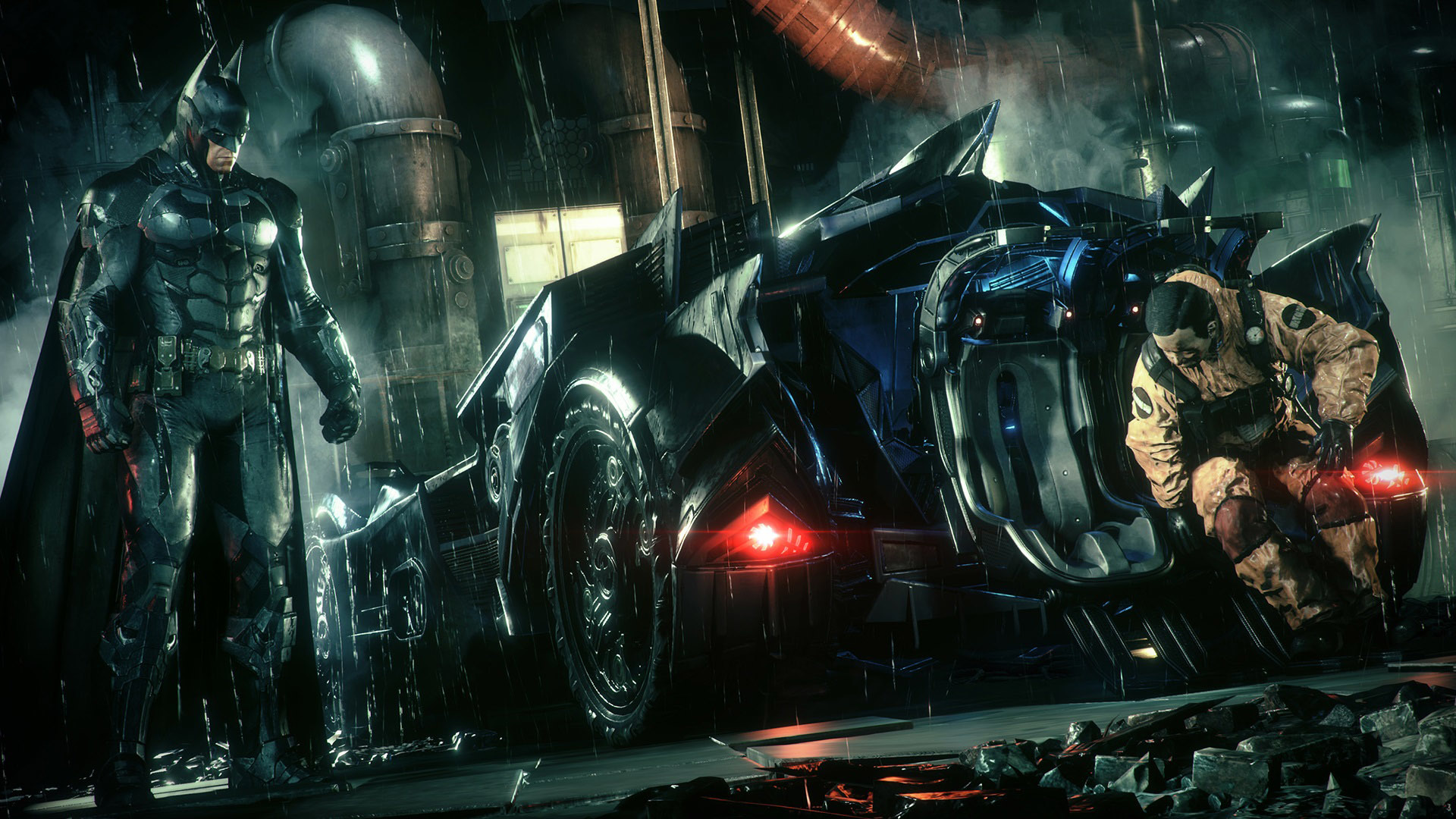
Batman: Arkham Knight (2015)
As a result, the corrected version of the game was released on PC a few months after the debut on consoles, it became more stable, but did not get rid of gluttony - the game used over 3 GB of video memory on high-resolution graphics and required a video card of the Radeon HD 7970 or GeForce GTX 780 level. In this respect, requests for the processor remained moderate - even dual-core Intel turned out to be enough so that the number of frames per second did not fall below 40 fps.
General principle: the video card is more important than the processor. High detail even in Full HD obeys only truly productive video accelerators.
What changed? In the new part of the game, at the time of release, instead of the “budget new” video cards, slightly outdated flagships began to demonstrate the minimum acceptable fps.
Tomb Raider / Rise of the Tomb Raider
Today the reprint of the game about Lara Croft looks frivolous from a technological point of view - even the outdated and cheap video accelerator GeForce GTX 950M comes from laptops. But four years ago, in 2013, the Crystal Engine engine in Full HD resolution became a daunting task for all budget-class GPUs. And with the AMD TressFX technology, which makes the main character's hair soft and silky, almost all video accelerators, with the exception of the flagship, are blown away.
Yes, and the consumption of 1080p video memory rested on an impressive 2 GB for those times.
But after all, the processors also did not spare the game. Moreover, the comfortable frame rate in the first versions of the game was possible only on four core processors. Unheard of impudence for 2013! In the later patches, the game was made less demanding of the CPU and exploring the tombs with Core i3 or older Pentium became a feasible task.

Tomb Raider (2013)
The Foundation Engine in Rise of the Tomb Raider, in much the same way, attacked the 2015 video accelerators. The consumption of video memory in DirectX 11 jumped beyond the limits of 3 GB, the frame rate suitable for playing in Full HD was given only to the newest video cards of a slightly older middle-end class. And the DirectX 12 mode “pleased” gamers with memory leaks, with the result that the game ate all 6 GB of VRAM in the flagship video accelerators of 2015 release!
Moreover, the DX12 did not bring relief to the processors - if in DirectX 11 AMD quad-core state employees and dual-core Core i3 felt comfortable, then with the activation of the new API, low-cost models dropped out of competition, and fps showed only miraculously survived “Hyper Threading is our everything” Core i3 and much more expensive processors of the "blue" and "red" camps.
General principle: the video card is more important than the processor. Video memory does not happen much.
What changed? Instead of "at least some" of four cores, the game began to demand high-performance CPUs or at least high-frequency Core i3. DirectX 12 slightly improved picture quality and dramatically degraded the performance of processors and video cards in the RoTR.
Auto racing
Need for Speed: Rivals / Need for Speed (2015)
Trite? And how! But nevertheless, NFS is such a convenient conveyor by which it is convenient to navigate the trends of games of the racing genre.
NFS Rivals was the first game of the series on the Battlefield Frostbite 3 engine, only, to put it mildly, with its interpretation. The developers have set a limit on the frame rate in the amount of 30 fps - either for greater “cinematography” of the picture, or in attempts to disaccustom PC players to pay attention to the graphic settings. Neither smoothing, nor smooth image, nor support for SLI - Ghost Games Studio clearly felt uncomfortable working with the new engine.
As a result, the “ultra-modern” graphically, Need for Speed worked comfortably on middle-class video cards and ... everything, we run into 30 frames per second. But enthusiasts have found a way to get around the restriction, so the competition ended on sub-flagship video cards, which resigned to 60 fps. Pretty nice, especially since the consumption of video memory in the game is not far from the usual 1 GB.
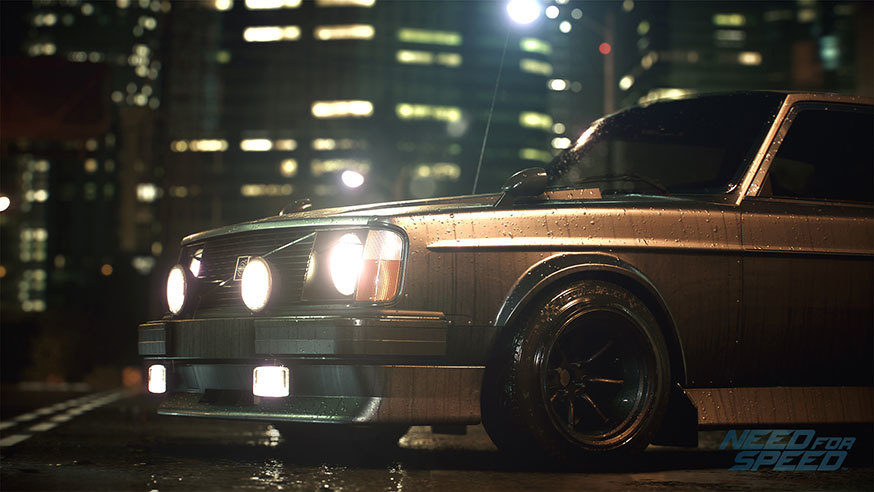
Need for Speed (2015)
But with the requirements for the processor, things were different (although it seemed to be races, why would they need a powerful CPU?), Because with the frame rate unlocked up to 60 fps, dual-core chips could no longer cope with the load and for a comfortable game they were needed, at least AMD FX-6100 high-frequency or Intel Core i3. Approximately the same situation in Battlefield 4, which was released on the same engine. Another thing is that for a dynamic shooter "borderline" 30 fps is too small.
Ported to a PC with a late Need for Speed 2015 release finally took down the questions “why do I need Frostbite in racing games?”. Because beautiful, very beautiful! With the engine completely refined, the game began to eat as much as 3 GB of video memory, but it didn’t change in its essence - for a comfortable game, the middle class video card (GeForce GTX 960 / Radeon R9 280X) is enough, and either Core i3 or AMD quad-core with high clock speed. Such requirements for the processor, by the way, made the new NFS "unplayable" on a huge number of laptops. But nothing can be done: Frostbite - he is also outside the Battlefield Frostbite.
General principle: the processor is more important than the video card. Graphic detail levels are barely distinguishable by eye.
What changed? Memory consumption has increased, but the status quo (“I eat a little less memory than in mainstream video cards”) has not changed. Requirements for the processor with the engine refinement and the unlocked frame rate have increased slightly.
Project CARS
Of course, it would be interesting to compare the works of Codemasters (GRID 2 / DiRT Rally), who are famous for optimizing the games, but the differences in such games are reduced only to nuances - the same engine, slightly more loyal system requirements for the 2013 game. However, this is still a look - in 2013, for a game without a drawdown of frame rates, a video card of the Radeon HD 7850 level was needed, which was middle class. And among processors, the game gratefully favored quad-core, although it kept acceptable fps on dual-core CPUs. In 2015, similar system requirements mean that DiRT “flies” even on budget gaming computers.

Project CARS (2015)
With Project CARS, the situation is different, because the game, for the development of which funds were collected by the “whole world,” has become one of the most beautiful and demanding auto-simulators of modern times. But its engine has grown from the old parts of Need for Speed - for example, Shift Unleashed 2011 release!
Graphic settings - darkness, and the ability to manually select the "high" or "maximum" presets no. With a crowded rifle of rivals, bad weather on the track and extremely high-detailed graphics, Project CARS looks like a documentary about car racing, and such beauty requires sacrifice. A lot of expensive GPU'shnyh victims - something between the GeForce GTX 770 or Radeon R9 280X. That is, CARS require video cards just above the average at the time of the game. With processors, the game also does not stand on ceremony - Core i3 as the minimum "entrance ticket" and preference for quad core with high frequency.
General principle: the video card is more important than the processor for high performance.
Open-world sandbox games
The name is exaggerated, but you understand what games we mean? The ones in which the developers boast about the simulation of the life of random characters on the streets. Games in which the seamless world is covered with secondary tasks with a unfolded storyline. Giant scenery and large-scale, let's say, drama.
Assassin's Creed IV / Assassin's Creed Syndicate
When Far Cry 3 was already outdated, and Watch Dogs had not yet appeared, Assassin's Creed was one of the main Ubisoft games in the open world. By 2013, the main characters, however, became strange (Indians and pirates - also a little assassin, although they had no relation to the Ismailis), but this is normal - the team of heroes from the movie “Fast and Furious” also switched from street racing to effective entrepreneurship.
The Anvi game engine already in those years was something akin to the Call of Duty skeleton that was constantly overgrowing with “ryushechkami”, but this absolutely did not prevent the game from being one of the most voracious in terms of iron among all titles that came out in 2013. Radeon HD 7970 and GeForce GTX 770 as a ticket for playing in Full HD with high quality - this is so-so optimization, you need to say. And from the processors, the game was preferred by quad-cores and with a higher frequency. At the same time, more than four threads in the processor miraculously pulled the CPU results down, so the fastest chips in Assassin's Creed IV were Intel Core i5. Everything, except the amount of video memory, in the computer had to be “expensive-rich” for the game to work properly.

Assassin's Creed Syndicate (2015)
However, this fun did not last long - in Assassin's Creed Syndicate, developers had to seriously optimize, because the previous AC: Unity just became a meme with extreme system requirements with a large number of bugs.
As a result, the game began to consume 3 GB of video memory already in and required, ashamed to say, the GeForce GTX 960 as the minimum acceptable option for “very high in 1080p). But it became much more loyal to the processors - even cheap Intel Pentium handled the load superbly.
General principle: the video card is more important than the processor. If you want to play well - buy video cards of the “above average” level.
What changed? The developers optimized the game for a more efficient use of the GPU and thus unloaded the processor.
Grand theft auto v
To understand why GTA 5 with all its pomp was well optimized, just look at the epic port from the old consoles, that is, the epic debut of the fourth part of the series on the PC in 2008. A more untalented game on the requirements for the processor was simply not to be found - you needed “only” Intel Core Quad (which was as expensive as the Core i7 today) in order for the mediocre port from the console tossed with more or less acceptable fps. Millions of gamers around the world sent curses to Rockstar for this optimization of the game.

Grand Theft Auto 5 (2015)
GTA 5 was released on the PC after almost a couple of years after the debut on the consoles of the old generation, that is, there was plenty of time for a quality port for developers. The Rockstar Advanced Game Engine was by now “licked out” for the current hardware, so the game, although it consumed indecently a lot of video memory (over 2 GB in Full HD), but without problems it even turned on budget video cards, such as the GeForce GTX 750, for example . With performance on dual-core processors, GTA 5 also did not experience any problems. The outrageous lightness of being by the standards of the PC industry, isn't it?
The general principle: low requirements for components, high requirements for the amount of video memory. At the same time, the video card is more important than the processor - the lesson with the gluttony of GTA IV to the CPU was not a gift for developers.
Strategy games
The overwhelming majority of strategies either torment the processor without special requirements for a video card, or upset with optimization so much that even top-end hardware does not save the situation. The latter cases should include real-time strategy Total War (Rome II, for example, which “forced” the hardware without any special graphic reasons) or the recent XCOM 2. They serve powerful quad-core processors and mid-level graphics cards (GTX 960, at least ) for a comfortable game in Full HD. The developers convince the players that this is a “bagofich”, the public is indignant.
True, such optimization becomes the exception rather than the rule, and we will follow the rules by other popular titles.
Civilization Beyond Earth / Civilization VI
The fifth part of the step-by-step simulator “rewrite history in its own way” came out back in 2010 and at that time was unusually demanding by the standards of strategic games — it was happy to eat over 512 MB of video memory and preferred either new middle-end video cards (GeForce GTS 450) or old ones flagships (GeForce GTX 285) in Full HD resolution. Processor performance became a separate “pain in the fifth point” for fans of the series, because without a quad-core CPU (or a good dual-core with four threads), Civilization was deliberately thought about when changing moves in the later stages of the game progress. Now you can ask “so what?”, But in 2010 even the “popular” high-frequency Core 2 Duo and AMD Phenom X2 got along poorly with the game.

Civilization VI (2016)
But released in 2014, Beyond Earth, which represented the fifth Civilization in the new scenery, was a surprisingly lightweight game for modern iron. Even the cheap Radeon HD 7770 easily crossed the border at 30 fps, and more was not necessary for a step-by-step game. And the budgetary dual-core Intel Pentium based on Haswell architecture easily mastered the load of the once voracious game for desktops.
In the case of Civilization VI, the change of generations of the game looks strange - the graphics are clearly not better, but the system requirements have grown to match the time. No one is insulted by the need to have the “middling” GeForce GTX 950 for Full HD resolution, and that’s why the CPU load has become 2 times higher since the times of Civilization 5 - a mystery. In any case, you won't be able to play more comfortably on Intel dual cores - you need at least a Core i3 level processor. Zhor video memory in the new game, by the way, the beyond - up to 4 GB in Full HD, and this is with a cartoon design!

Graphic Evolution in Civilization V and VI
But support for DirectX 12 in Civ 5 was not mockery of iron, as in the Rise of Tomb Raider, but a really useful way to reduce the load on the processor - up to 10-15% increase in fps on DirectX 12 compatible configurations.
General principle: the processor is more important than the video card, although the GPU requires a lot of video memory.
What changed? The load on the CPU with the change of parts of Civilization is growing faster than the graphics adapter, but support for DirectX 12 allows you to significantly "release" the processor.
StarCraft II: Legacy of the Void
Truly popular real-time strategies remain “fresh” thanks to DLC / remastering in spite of the year the original was produced. Thus, the Cossacks 3 are arranged, and the second part of StarCraft, originally from 2010, terribly to say, went the same way as from the system-demanding novelty to an elementary game that can be run in Full HD even on the integrated graphics. Therefore, the pleasure of one of the best RTS is inexpensive - just a middle-aged GeForce GTS 450 or Radeon HD 7750 is enough to deny 1080p to yourself.
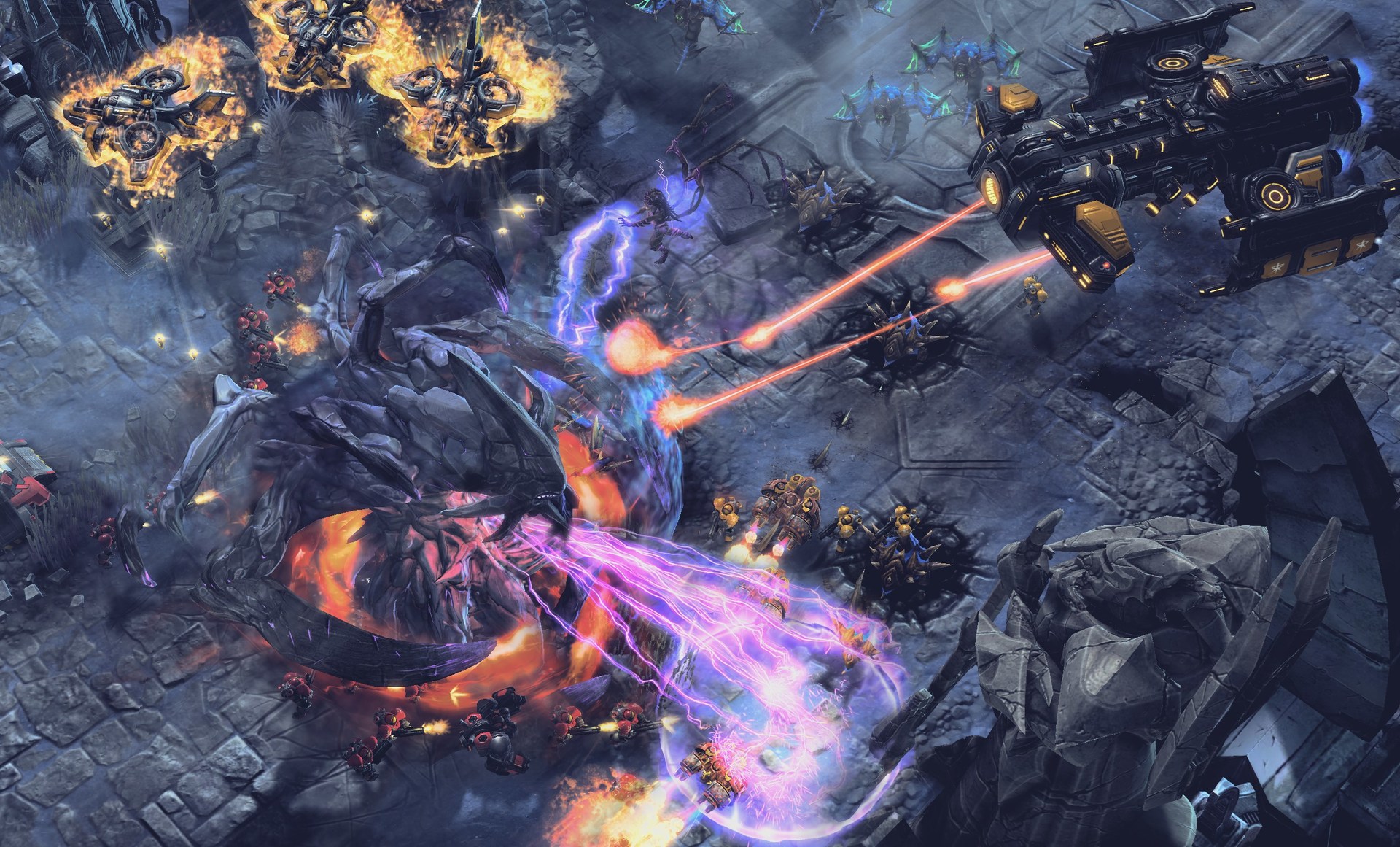
StarCraft II: Legacy of the Void (2015)
In the case of processors, we observe a situation that is funny in our times, when the number of cores is not as important as the performance and frequency of each of them. In general, the Core i3 whizzes around AMD's eight-core chips and is almost equal to the older Intel chips in frame rates.
General principle: the processor is more important than the video card, the load on the GPU is very low.
What changed? Nothing! The game still lives in the past and loves fast dual-core processors, not “swaying” the new hardware properly.
MMORPG, MOBA and free-to-play games
Games in which the emphasis is on mass character remain the most iron-friendly even in 2016. Dota 2 works without any problems on the cheapest video card of the new years (Radeon HD 7750) and at least some dual-core processor, World of Tanks is content with video cards of the “below average” class (GeForce GTX 750 Ti) and processors slightly better than the budget Intel Pentium new years. Similarly, the online shooter Overwatch behaves, so for the massive online and free-2-play games today even the budget configuration itself will be enough.

In mass online games, system requirements fade into the background - the game should start and work for any more or less solvent audience.
And what about the other components?
On the processor and video card in the computer, the light did not come together with a wedge, but they represent the "foundation" of the gaming computer. When choosing a power supply, you need to look at the power (which calculators are not considered to be ), the efficiency and amperage on the individual lines. In general, this is a separate conversation with its own nuances.
In order for the games to "just work normally", there is enough budget Kingston ValueRAM RAM, sets with a high frequency allow you to play a little more fps "through I can not", and overclocking memory meekly withstands high loads and for this reason will please those who look at the frame rate is not from the standpoint of “it will come down to me”, with the aim “you can do it even faster.”

Economical gamers suit inexpensive Kingston UV400 as a system disk. To speed up the download of games, it is desirable to acquire HyperX Savage
A solid-state drive does not directly affect the number of frames per second - it affects the speed of loading levels. The larger the game world, the more noticeable the difference. Therefore, even an inexpensive HyperX Fury will help you to arrive faster on the battlefield in online games or less to look at the slideshow to the music, while the computer brings the game into battle mode.
The steeper the drive, the more noticeable the difference, even if “on paper” for a few seconds seems trivial.
Today we understood a lot
You see the new game of Electronic Arts authorship - wait inside the Frostbite engine and high demands on the processor with modest appetites for the video card. You see a game about “stalkers” - prepare a flagship video accelerator and CPU, or tolerate reduced graphics detail. Wanted to be Batman - prepare a productive video card, and the adventures of the beautiful Lara Croft are fraught with even the insatiable consumption of video memory.
Do you like Battlefield - love and Need for Speed (the performance is the same), but be prepared for the fact that for really cool graphics in racing games you need at least a cool graphics card than for shooters.
The old Ubisoft sandboxes are voracious in all Ubisoft sandboxes. In new games there is already an opportunity to save on the processor.
GTA has long ceased to be a “curved port from consoles” - an average computer with a graphics accelerator of three or four gigabytes of video memory is sufficient for it. Strategies on PCs are unpredictable: some of them are designed by mediocre studios, so the games “slow down” on any components, some of them are alterations of old games for which powerful hardware is not needed.
And only massive online games (especially pay-to-win) will take a PC player into open arms with iron of almost any level. But all these conclusions do not answer the main question:
How to build a cheap and high-quality computer for games?
, « 64 » , , Full HD, :
- NVIDIA GeForce GTX 1060 6 . .
- , — Core i5. — Core i5-7400 7500 (Intel Kaby Lake). «», , «» . , Core i7.
- Kingston DDR4 16 . Kingston — , 16 «» — 8 ( ), .
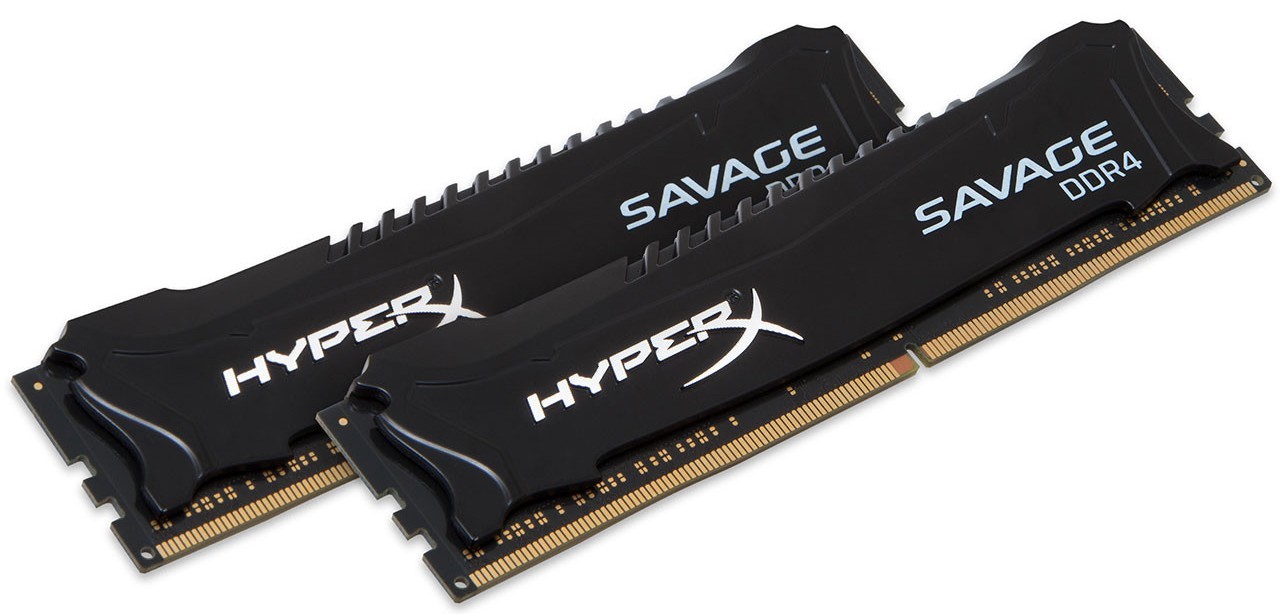
, . , ...
- 550 , — . .
- — Kingston UV400 HDD «» . , — HyperX Savage 240 .
- Salt, pepper to taste. .
, , « — ». , ! , , Kingston/HyperX. Starring:
— 12% DDR4 Predator . GEEKPR16 — 31 2016 «» .
— ? 10% Savage DDR3/DDR4 HyperX Savage. SAVAGE16 28 2016 .
— , . KING16 28 10% Kingston ValueRAM!
- to improve in the computer in the new year is not only everything, so we also prepared a discount of 500 rubles for gaming headsets HyperX Cloud Stinger and Cloud Drone in the DNS network. Hurry up to December 25 !
- HyperX CloudX buyers in Yulmart will receive Xbox Live Gold gold status for three months.
- and, finally, to effectively combat those who are wrong on the Internet or trying to defeat you in a network game, we offer a discount of 1,500 rubles for HyperX Alloy gaming mechanical keyboards in the DNS network! The promotion applies to models with switches Cherry MX Blue / Red / Brown is valid until December 25 .
Happy all! Subscribe and stay with us - it will be interesting!
For more information about Kingston and HyperX products, visit the company's official website . In choosing your kit HyperX help page with visual aids .
Source: https://habr.com/ru/post/399951/
All Articles